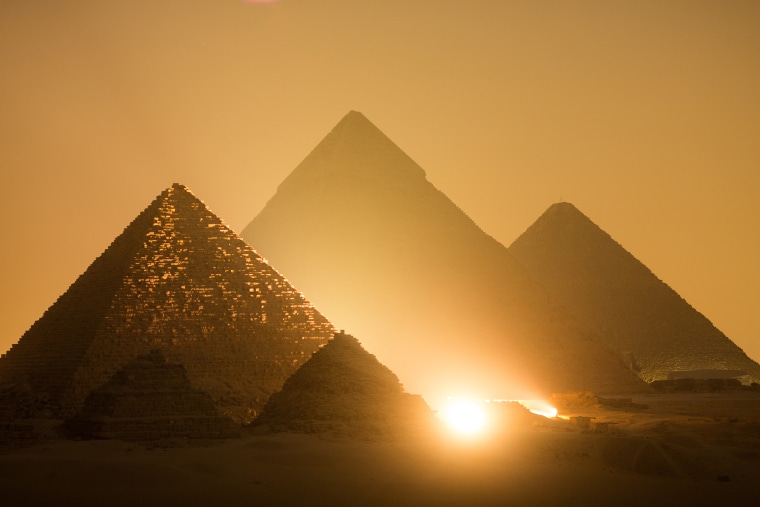A new effort to scan Egypt's Great Pyramid of Giza using energetic particles from space could help scientists "see" inside the ancient structure and glean new details about its mysterious inner chambers.
The Great Pyramid is the largest pyramid of Giza, towering 455 feet tall, and the only one of the Seven Wonders of the Ancient World left standing. Researchers working with the Exploring the Great Pyramid Mission are raising money to develop a high-powered telescope to map its internal makeup from all angles.
The device would have "upwards of 100 times the sensitivity" of equipment that has previously been used to study the archaeological site, said the project’s leader, Alan Bross, a staff scientist at the Fermi National Accelerator Laboratory, a government-run facility in Batavia, Illinois.
The telescope would scan the pyramid with cosmic ray muons, high-energy particles that are created when cosmic rays from outer space rain down and collide with atoms in Earth’s atmosphere.
"It's natural radiation," Bross said. "Cosmic ray muons impinge upon the surface of the planet all the time. They're going through us now."
The proposed scans were detailed in a study published March 6 in the Journal for Advanced Instrumentation in Science.
Cosmic ray muons can pass through solid objects more effectively than X-rays, allowing scientists to peer inside structures that are normally impenetrable. As muons move through the pyramid, the high-energy particles interact with different materials — granite or limestone, for instance, or air in an open cavity — deflecting their energy and light in measurable ways. Researchers can use the measurements to create detailed maps of its interior, Bross said.
The Great Pyramid of Giza was thought to have been constructed at the request of the pharaoh Khufu, who reigned during the 26th century B.C.
Luis Alvarez, a physicist, first explored the idea to probe the pyramid using cosmic rays in the late 1960s. Alvarez and his team scanned about 19 percent of the pyramid over two years but found no previously undetected chambers inside the iconic structure, according to the American Physical Society.
The muon technique was used again in 2017 as part of a separate project called ScanPyramids, which yielded one of the most significant discoveries at the site in recent years: the existence of a large, hidden void above a known passageway called the Grand Gallery. The puzzling feature, dubbed the "Big Void," is around 20 feet high and nearly 100 feet long, and its purpose is still unknown.
The Exploring the Great Pyramid Mission is designed to build on the ScanPyramids findings, using a larger and more advanced telescope that can detect trillions of incoming cosmic ray muons to produce higher-resolution images from multiple vantage points, Bross said.
He said the resulting scans could reveal what the sprawling chamber was once used for, including what — if any — objects are inside.
"If the Big Void was a staging area or some kind of construction site and there was debris left in there, we would see that," Bross said.
In addition to the Grand Gallery, archaeologists previously found the king's chamber, roughly in the center of the pyramid, and a smaller queen's chamber nearby. But many other details of the pyramid's internal structure are not well understood, Bross said.
The new muon detectors would be built inside up to eight standard shipping containers, each measuring 40 feet long, 10 feet tall and 10 feet wide, according to the researchers. The telescope system would be placed at different spots all around the base of the pyramid, gathering observations at each position for three months at a time, Bross said.
He estimates that it would take three years to accumulate enough data to create a high-resolution map of the entire pyramid. Bross said the team has secured funding from the Big Ideas Generator, a grant program at the University of Chicago, and the Fermi National Accelerator Laboratory to conduct initial computer simulations to serve as a proof of concept. Building the detectors and carrying out the scans, however, would be likely to cost $5 million to $10 million, he said.
Bross said that once the telescope system exists, however, it could be used for other archaeological expeditions.
"One idea would be to take it to the Valley of the Kings [in Egypt] and look for density variations in the mountains," he said, "which might be indicative of undiscovered tombs."

